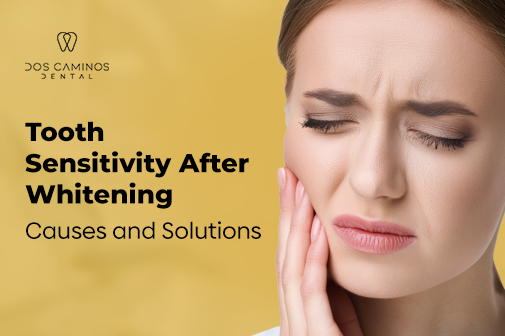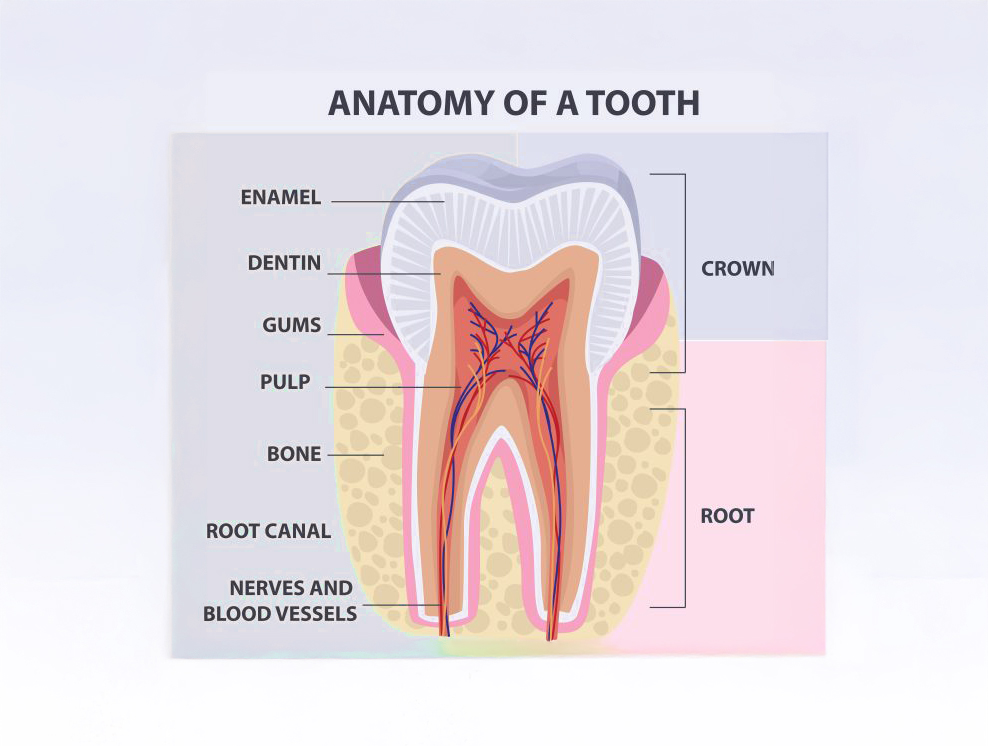
A dazzling, beautiful smile is a dream of many. However, sometimes stubborn stains can eclipse the shine, leaving people searching for options to restore their pearly whites. One such treatment that has gained popularity over the years is teeth whitening strips. It’s easy, effective, and shows visible results.
But the shine is sometimes accompanied by an uninvited guest. Sensitivity and the unbearable pain after teeth whitening. Although temporary, the sudden zing in your teeth can feel uncomfortable when you have something hot or cold.
In this blog, we’ll help you understand why this happens and how to maneuver your way out of the discomfort and go back to flaunting that beautiful, confident smile.
How Do Teeth Whitening Agents Work?
Whether you’re using whitening strips, gels, trays, pens, or getting a professional in-office treatment, most teeth whitening products rely on one key ingredient: peroxide, usually in the form of hydrogen peroxide or carbamide peroxide.
These agents act as powerful bleaching compounds. When applied to the teeth, they penetrate the enamel (the outer protective layer) and reach the dentin underneath, where most stains settle. The peroxide breaks down the colored molecules in stains, effectively making your teeth appear whiter and brighter.

Why Do My Teeth Hurt After Using Whitening Strips?
As the peroxide in the strips penetrates the enamel, it opens up tiny pores on the tooth’s surface to reach and break down deep-set stains. In the process, it can also temporarily expose the underlying dentin and irritate the nerve endings inside your teeth, leading to that sharp, aching sensation known as tooth sensitivity.
The higher the concentration of peroxide in the strips and the longer you leave them on, the more likely you are to experience this sensitivity. It’s especially common if you already have thin enamel, gum recession, or untreated dental issues.
The good news? This discomfort is usually temporary and can be easily managed with the right care—something we’ll cover in the sections ahead.
Looking for a dentist in Camarillo, CA?
Book your appointment with us todayWho’s More Likely to Experience Sensitivity?
Some people may be more prone to tooth pain after whitening strips than others. It really depends on the product you use and your tooth health. You might feel the sting more if:
- You already have sensitive teeth
- Your enamel is naturally thin
- You’ve had gum recession or exposed tooth roots
- You overuse whitening products
- You use high-concentration products without supervision
| How to Relieve Tooth Pain From Whitening Strips? If your pearly whites are crying out in pain, try these remedies: – Use a toothpaste made for sensitive teeth – Avoid hot, cold, or sugary foods for a few days – Rinse with warm salt water to reduce inflammation – Switch to a soft-bristled toothbrush – Try a fluoride gel or desensitizing agent (ask your dentist) – Take a break between whitening sessions if you’re using a multi-day treatment |
When Should You Seek Professional Help?
Mild sensitivity after whitening is common and typically goes away on its own within a few days. But if the discomfort lingers or worsens, it could be a sign that something else is going on beneath the surface.
Here’s when it’s time to consult a dentist:
1. Sensitivity Won’t Subside
If the sharp twinges or dull aches don’t ease up within 7–10 days, it’s best to get a professional opinion. Prolonged sensitivity could indicate enamel erosion or an underlying dental issue.
2. Pain Is Severe or Constant
A little zing is normal, but intense or throbbing pain is not. If you’re wincing every time you sip water or breathe through your mouth, you would want to get it checked.
3. You Notice Gum Irritation or White Patches
Whitening products that come into contact with your gums can cause tissue irritation. If you see white spots, experience swelling, or your gums feel sore or raw, seek advice promptly.
4. This Isn’t the First Time Teeth Hurt After Whitening Strips
If every whitening attempt leads to serious discomfort, you might benefit from a gentler treatment plan or dentist-supervised whitening treatment.
How Often Should You Go for Teeth Whitening Treatments?
As whitening agents are strong and make your teeth sensitive after whitening strips, you should not opt for them more than a couple of times.
A good rule of thumb:
- At-home treatments: Every 4–6 months
- Professional whitening: Once or twice a year
But it is important to consult your dentist before beginning any treatment. This is especially required if you have experienced sensitivity in the past.
| Check out our detailed blog if you want to learn more about teeth whitening treatments. Read Here |
What to Avoid After Teeth Whitening?
We have already answered your question, “Why do my teeth hurt after whitening strips?” But another important aspect people often skip is the aftercare.
As your teeth are more sensitive and porous immediately after teeth whitening, it is advisable to avoid certain things to prevent re-staining or irritation of the enamel. Just like you would not spoil a freshly cleaned white shirt, right?
Here’s what you should avoid immediately after whitening:
1. Dark-Colored Drinks (Coffee, Tea, Red Wine, Cola)
These beverages are some of the most common culprits behind tooth stains. After whitening, your enamel is slightly more porous, making it easier for these dark liquids to seep in and undo all your progress. If you must indulge, use a straw to reduce contact with your front teeth.
2. Highly Pigmented Foods (Tomato-Based Sauces, Soy Sauce, Curry, Berries)
Foods rich in color aren’t great for freshly whitened teeth. The particles can cling to your enamel and cause stains to reappear faster. Stick to lighter-colored meals like rice, steamed veggies, chicken, or pasta with white sauce for the first 48 hours.
3. Tobacco Products
Smoking or chewing tobacco not only stains teeth but also slows down healing and can intensify sensitivity. If there’s ever a perfect time to cut back—or quit—this is it.
4. Aggressive Brushing
Your teeth are sensitive post-whitening, and brushing too hard or using a hard-bristled toothbrush can irritate the enamel and gums. Use a soft-bristled brush and gentle circular motions to clean your teeth without causing more discomfort.
5. Back-to-Back Whitening Treatments
It’s tempting to double up on treatments for quicker results, but this can damage your enamel and lead to lasting sensitivity. Always follow the product instructions and give your teeth time to recover between sessions.
| To Eat or Not to Eat? Here’s What To Eat to Prolong Your Teeth Whitening Results Read Here |
How to Maintain That Sparkling Smile?
Want to avoid needing whitening procedures every few months and skip the dreaded ‘teeth hurt from whitening strips’ feeling? Prevention is key:
| Pro Tips for a Brighter Smile: – Rinse your mouth after meals or coffee – Chew sugar-free gum to boost saliva – Use a straw for stain-causing drinks – Brush twice daily and floss regularly – Get regular dental check-ups |
Final Words
Dealing with sensitive teeth after whitening your smile can take away from the excitement, but the good news is, it’s usually temporary. With the right care and precautions, most people find relief within a few days.
However, if the sensitivity persists or worsens, don’t ignore it. Schedule a visit with your dentist. And remember, it’s always best to consult a dental professional before starting any whitening treatment, especially if you have a history of sensitivity or other oral health concerns.
If you’re considering teeth whitening, visit Dos Caminos Dental in Camarillo, CA. Our advanced technology, state-of-the-art equipment, and compassionate team ensure your treatment is safe, effective, and tailored to your unique needs.
 2438 N Ponderosa Dr, C-111, Camarillo, CA 93010
2438 N Ponderosa Dr, C-111, Camarillo, CA 93010





